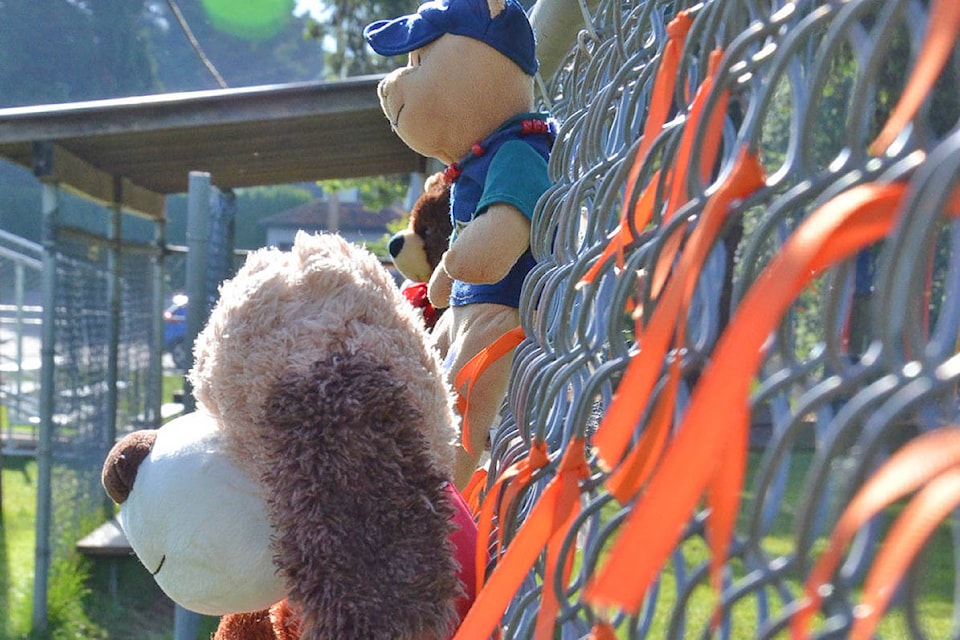I don’t ever want to live in a big house with too many doors, too many windows and too many empty silent rooms. If I am ever able to afford to live in a big home like the pink mansion on the hill just before N’dilo, I want to fill it with happiness. With the laughter of my children, my grandchildren and my great grandchildren. I want to fill it with love.
The residential school was a big house too, but it was not a home. It was a house with many many rooms all filled with children who were not laughing but crying for having to be removed from their homes and live in harsh inhumane conditions. Many of the children who were shipped to residential school died at the hands of their abusers or from sickness and disease from the inhospitable environments they found themselves trapped in. These schools were situated all across the country, with questions left unanswered about what happened to the children who were unaccounted for. Kamloops is the first of many answers that are now being unearthed. Driving past Kamloops many times on my way to and from university, I always had an eerie feeling like it was a place with a dark past almost like a secret cult operated in the area and now I understand why that feeling resonated with me so strongly.
My grandmother went to Sacred Heart Residential School in Fort Providence. She wasn’t from that area but was shipped there just like every other child in the north. From one community to the next they were taken and placed at that school where they were fed rotten fish, scrubbed with a wire brush and had their heads dunked in kerosene among other horrific crimes.
Around the time when the Indian Act was established, the abolishing of Indigenous peoples was the priority of the government, the police and religious groups together. A trio of powerful institutions working together caused over a century long genocidal campaign that has impacted every single Indigenous person in Canada. These same institutions are still committing crimes to this day but now they are being held somewhat to account. They can no longer hide behind the lies, they are exposed for what they have done and will continue to be exposed. They have failed in their mission to eradicate entire populations of Indigenous people. Their plan has backfired because Indigenous communities are stronger than ever, demanding and determining sovereignty by exercising their inherent rights.
I sat in a circle in K’atl’odeeche when the government put on a witness blanket exercise. At the end each participant was asked to share what it meant for them to be there. A white-haired senior sat alone off to the side. He seemed hesitant to be a part of the circle. He was quiet until he was given the talking stick. When he spoke, he spoke without emotion. He told the large group that he himself was a teacher at one of the residential schools. I wondered what it must have felt like for him to know he had a hand in the rippled effects of intergenerational trauma that was created out of the residential schools. Yes, along with the survivors who are still alive to tell their story, there are those on the other side who also have a story as well, a story most likely filled with guilt and shame for participating in the imposition of an institutional regime that shook every single Indigenous community to their very core.
When I worked for the government, I was at one of many lunch meetings. The conversation at the time was about how the firefighters were being allocated to different communities across the north to fight fires during the time when the fires were out of control. My ears perked up when one of the higher up employees had the audacity to say that the communities should just be amalgamated into one. He was of the mind that small northern communities were taking up too much government resources and should have been abandoned long ago. This man had no understanding of the importance of community or how important land and place are in direct relation to who we are as Indigenous peoples. These are the opinions of some people who are living, working and making decisions in our communities. More needs to be done to ensure that only people with the best intentions - with cultural awareness and allyship – are welcome to live and work in our northern communities.
Despite all that Indigenous communities across the Nation were up against; dispossession, assimilation, encroachment we all have one thing in common – we stood strong through it all and are still standing strong.
The government would like to speed up the process of the Truth and Reconciliation calls to Action but the truth is that we are only at the truth part and might never get to reconciliation in our lifetime. The children in Kamloops were found by the First Nation themselves. Not by the government, not by the police, not by the church. Not by those who had a hand in hiding the truth. We cannot heal until we bring our children home and it is the Indigenous peoples who are the ones doing this difficult work.
As a child I was taught that the residential school legacy happened so long ago, that it shouldn’t be talked about anymore, that I shouldn’t be impacted by it - but I am. We all are.
There too many big houses with too many doors, too many windows, and too many empty silent rooms. We need to go back. All the way back to that small humble shack with a warm woodstove and the sounds of our children’s laughter.
